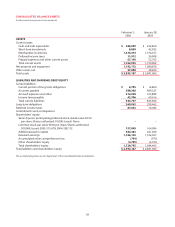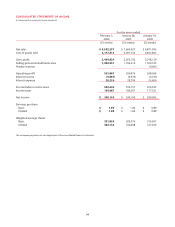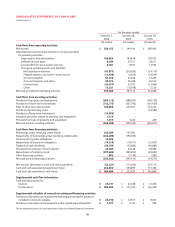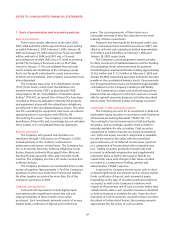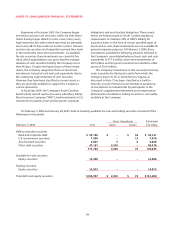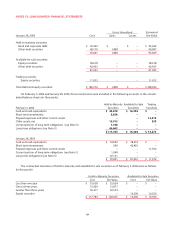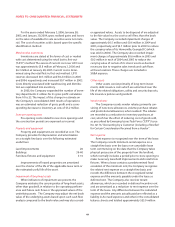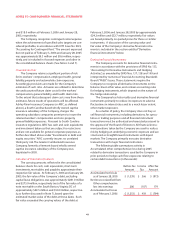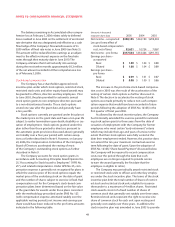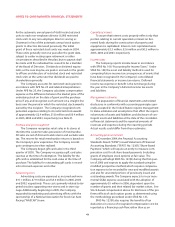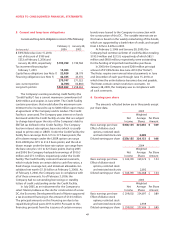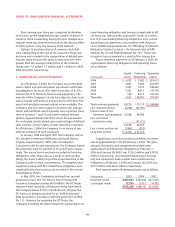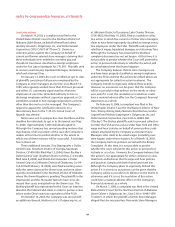Dollar General 2005 Annual Report Download - page 47
Download and view the complete annual report
Please find page 47 of the 2005 Dollar General annual report below. You can navigate through the pages in the report by either clicking on the pages listed below, or by using the keyword search tool below to find specific information within the annual report.
43
NOTES TO CONSOLIDATED FINANCIAL STATEMENTS
for the automatic annual grant of 4,600 restricted stock
units to each non-employee director (6,000 restricted
stock units to any non-employee director serving as
Chairman) in lieu of the automatic annual stock option
grants to directors discussed previously. The initial
grant of these restricted stock units was made in 2004.
These units generally vest one year after the grant date,
subject to earlier vesting upon retirement or other
circumstances described in the plan, but no payout shall
be made until the individual has ceased to be a member
of the Board of Directors. Dividends or dividend equiva-
lents, as the case may be, are paid or accrued on the grants
to officers and directors of restricted stock and restricted
stock units at the same rate that dividends are paid to
shareholders generally.
The Company accounts for restricted stock grants in
accordance with APB No. 25 and related interpretations.
Under APB No. 25, the Company calculates compensation
expense as the difference between the market price of the
underlying stock on the date of grant and the purchase
price, if any, and recognizes such amount on a straight-line
basis over the period in which the restricted stock award is
earned by the recipient. The Company recognized com-
pensation expense relating to its restricted stock awards
of approximately $2.4 million, $1.8 million and $0.4 million
in 2005, 2004 and 2003, respectively (see Note 9).
Revenue and gain recognition
The Company recognizes retail sales in its stores at
the time the customer takes possession of merchandise.
All sales are net of discounts and returns and exclude sales
tax. The reserve for retail merchandise returns is based on
the Company’s prior experience.The Company records
gain contingencies when realized.
The Company began gift card sales in the third
quarter of 2005. The Company recognizes gift card sales
revenue at the time of redemption. The liability for the
gift cards is established for the cash value at the time of
purchase.The liability for outstanding gift cards is record-
ed in Accrued expenses and other.
Advertising costs
Advertising costs are expensed as incurred and were
$15.1 million, $7.9 million and $5.4 million in 2005, 2004
and 2003, respectively. These costs primarily related to tar-
geted circulars supporting new stores and in-store sig-
nage. Additionally, beginning in 2005, the Company
expanded its marketing and advertising efforts with the
sponsorship of a National Association for Stock Car Auto
Racing (“NASCAR”) team.
Capitalized interest
To assure that interest costs properly reflect only that
portion relating to current operations, interest on bor-
rowed funds during the construction of property and
equipment is capitalized. Interest costs capitalized were
approximately $3.3 million, $3.6 million and $0.2 million in
2005, 2004 and 2003, respectively.
Income taxes
The Company reports income taxes in accordance
with SFAS No. 109,“Accounting for Income Taxes.” Under
SFAS No. 109, the asset and liability method is used for
computing future income tax consequences of events that
have been recognized in the Company’s consolidated
financial statements or income tax returns. Deferred
income tax expense or benefit is the net change during
the year in the Company’s deferred income tax assets
and liabilities.
Management estimates
The preparation of financial statements and related
disclosures in conformity with accounting principles gen-
erally accepted in the United States requires management
to make estimates and assumptions that affect the report-
ed amounts of assets and liabilities and disclosure of con-
tingent assets and liabilities at the date of the consolidat-
ed financial statements and the reported amounts of
revenues and expenses during the reporting periods.
Actual results could differ from those estimates.
Accounting pronouncements
In December 2004, the Financial Accounting
Standards Board (“FASB”) issued Statement of Financial
Accounting Standards (“SFAS”) No. 123(R),“Share-Based
Payment,” which will require an entity to measure com-
pensation cost for all share-based payments (including
grants of employee stock options) at fair value. The
Company will adopt SFAS No. 123(R) during the first quar-
ter of 2006 and expects to apply the standard using the
modified prospective method, which requires compensa-
tion expense to be recorded for new and modified awards
and also for unvested portions of previously issued and
outstanding awards. The Company expects to incur incre-
mental SG&A expense associated with the adoption of
approximately $5 million in 2006, dependent upon the
number of grants and their related fair market values. See
Stock-based compensation above for disclosure of the pro
forma effects of stock option grants as determined using
the methodology prescribed under SFAS No. 123.
SFAS No. 123(R) also requires the benefits of tax
deductions in excess of recognized compensation cost be
reported as a financing cash flow, rather than as an


